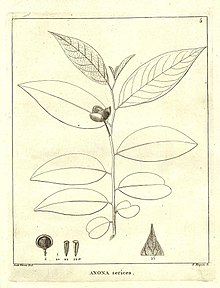Annona sericea
| Annona sericea | |
|---|---|

| |
| Botanical illustration of Annona sericea | |
| Scientific classification | |
| Kingdom: | Plantae |
| Clade: | Tracheophytes |
| Clade: | Angiosperms |
| Clade: | Magnoliids |
| Order: | Magnoliales |
| Family: | Annonaceae |
| Genus: | Annona |
| Species: | A. sericea
|
| Binomial name | |
| Annona sericea | |
| Synonyms | |
|
Annona jenmanii Saff. | |
Annona sericea is a species of
Description
It is a tree reaching 1.3–2 meters in height. Its young branches are covered in deep red silky hairs. Its leaves are arranged in opposite rows. Its oblong, membranous leaves are 10.5-18 by 3.5-5.5 centimeters and come to a point at their tip. The leaves have numerous small spots which transmit light. The leaves are hairless on their upper surface, but hairy on their lower surface – particularly the midrib and veins which have dark red silky hairs. The leaves have 18-25 secondary veins emanating from either side of the midrib. Its petioles are 4-8 millimeters long, and covered in rust-colored silky hairs. Its flowers are on peduncles that are 11-16 millimeters long, extra-axillary, and occur alone or in pairs. The peduncles are covered in fine rust-colored hairs and have a bracteole at their midpoint. The sepals are united to form calyx with 3 oval to triangular lobes that come to a point. The outer surface of the calyx is covered in dark red hairs. Its flowers usually have 3 petals but can have 6, arranged in two alternating rows of 3. The thick, oval, concave petals are 12-16 by 10-12 millimeters, come to a shallow point. The margins of the petals touch but are not united. The outer surface of the petals is covered in rust-colored fine, silky hairs, the inner surface is covered in tawny yellow, woolly hairs. The convex receptacle of the flowers is 6 millimeters in diameter and covered in wispy yellow hairs. Its flowers have numerous stamens that are 1.8-2.2 millimeters long with short, flat filaments and 1.5-1.7 millimeter long anthers. The tissue connecting the lobes of the anthers is overgrown to form a hood covered in stiff hairs. Its carpels and club-shaped styles are 1.8-2.2 millimeters long. Its ovaries are covered in red silky hairs. Its immature, oval fruit are 2.5 centimeters long and 1.5 centimeters in diameter and covered in cone-shaped projections. Its seeds are oval and have a caruncle at one end.[5][6][7]
Reproductive biology
The pollen of Annona sericea is shed as permanent tetrads.[8]
References
- . Retrieved 28 April 2021.
- ^ "Annona sericea Dunal". Plants of the World Online. The Trustees of the Royal Botanic Gardens, Kew. n.d. Retrieved January 4, 2019.
- ISBN 9780881926279.
- ISSN 0305-1978.
- ^ Dunal, Michel-Félix (1817). Monographie de la famille des Anonacées [Monograph of the family Anonaceae] (in French and Latin). Paris: Treuttel et Würtz.
- ^ Safford, William E. (1913). "Annona sericea and its Allies". Contributions from the United States National Herbarium. 16: 263–275.
- ^ Cuvier, Frédéric (1818). Dictionnaire des Sciences Naturelles (in French). Strasbourg: F. G. Levrault.
- S2CID 249081277.

